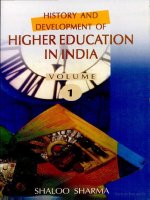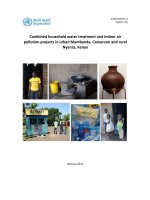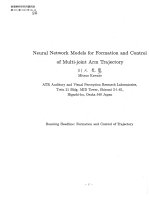Subalternity, state formation and movements against hydropower projects in india, 1920 2004
Bạn đang xem bản rút gọn của tài liệu. Xem và tải ngay bản đầy đủ của tài liệu tại đây (5.32 MB, 301 trang )
1
SUBALTERNITY, STATE-FORMATION AND
MOVEMENTS AGAINST HYDROPOWER PROJECTS
IN INDIA, 1920-2004
Arnab Roy Chowdhury
A THESIS SUBMITTED
FOR THE DEGREE OF DOCTOR OF PHILOSOPHY
DEPARTMENT OF SOCIOLOGY
NATIONAL UNIVERSITY OF SINGAPORE
2014
2
DECLARATION
I hereby declare that this thesis is my original work and it has been written by me in its entirety. I
have duly acknowledged all the sources of information, which have been used in this thesis. This
thesis has also not been submitted for any degree in any university previously.
Signature:
Date: 29.04.2014
3
ACKNOWLEDGEMENT
In the course of writing my doctoral dissertation I have received countless benefits, both direct
and indirect, from several people, organizations and institutions. Naming each and every one of
them will not probably be possible in this brief acknowledgement.
First of all I pay my heartfelt gratitude to Dr. Daniel P S Goh (Supervisor) and Dr. Anne Raffin
(Co-Supervisor) whose consistent support, advice, love and guidance helped me finish my
dissertation and enriched my graduate life in the Department of Sociology, National University
of Singapore. I also extend my sincere thanks to Dr. Rahul Mukherji, my dissertation committee
member, who has been a friend, family, philosopher and guide who gave me moral and
emotional support in a foreign land. My sincere gratitude for my thesis committee member Prof.
Vedi Hadiz (Murdoch University, Australia), who, despite the physical distance never forgot to
reply to my e-mails. My deepest gratitude to Prof. Chua Beng Huat whose kind and encouraging
support helped me navigate through my PhD. I am really thankful to Dr. Misha Petrovic for
being kind and generous to me and my friends. Despite their busy schedule, Prof. Prasenjit
Duara, Dr. Manjusha Nair, Dr. Kurtulus Gemici, Dr. Gyanesh Kudaisya, Dr. Volker Schmidt,
Dr. Vineeta Sinha, Dr. Eric Thompson Dr. Syed Farid Alatas, Dr. Shukadeb Naik and Dr.
Anand Kumar made themselves available for me whenever I required their help, I am really
thankful for their generosity.
My deepest gratitude for the husband-wife duo, Dr. Bharat Patanker and Dr. Gail Omvedt, the
coordinators of Shramik Mukthi Dal (Maharashtra), for being welcoming and helpful to me.
They shared significant information, views, ideas, personal archives, food and warm memories
with me. My sincere thanks to Medha Patker (main coordinator of Narmada Bachao Andolan in
Madhya Pradesh) and Rahul Banerjee (main coordinator of Khedut Mazdoor Chetna Sangath in
4
Madhya Pradesh) for candidly sharing information and documents about movements against
hydropower projects with me.
I also thank – Baba Adhav (MRDPSP), Somnath Waghmore (SMD), Suhas Paranjpe
(SOPPECOM, Pune), K.J. Joy (SOPPECOM, Pune), Anant Phadke (CEHAT, Pune), Shripad
Dharmadhikari (Manthan, Pune), Vijay Paranjpe (Gomukh Environmental Trust, Pune), Ashis
Kothari (Kalpavriksha), Suhas Palshikar (Pune University), Enakshi Ganguly Thukral (HAQ,
Delhi), Dr. Priya Sangameswaran (CSSS, Kolkata), Dr. Prachi Deshpande (CSSS, Kolkata),
Dr.Vasudha Dagamvar (Pune), Dunu Roy (Hazard Centre), Dr.Renu Modi (Mumbai University),
Dr.Livi Rodrigues (Pune), Dr. Subodh Wagle (Prayas), Prof. D.S. Dhanagare (Pune), Prof.
Parasuraman (TISS), Dr. Abhay Tilak (Indian School of Political Economy), Joel Cabalion
(EHESS, Paris), Anand Kapur (SHASHWAT), Kusum Karnik (SHASHWAT), Budhaji Damse
(SHASHWAT), Harsh Mander (NAC, India member), Suniti Suru (NBA, Pune), Dr. Anup Dhar
(Ambedkar University), Dr. R.N. Sharma (TISS), Anupam Mishra (Gandhi Foundation),
Kishwar Jahan (Bhopal) and Dr. Sarjerao Slaunkhe (Kolhapur University) for formally and
informally sharing information, documents and ideas with me in the most uninhibited manner. I
extend my sincere thanks to all those countless social activists and movement participants who
generously shared their time, pain and angst, without any inhibition or doubt. It is because of
their help that writing this thesis was possible.
I also thank- the National Archives of India (Delhi), the Maharashtra State Archives (Bombay
and Pune Branch), the Madhya Pradesh State Archives (Bhopal), the Gokhle Institute of Politics
and Economics (Pune), Yashwant Rao Chavan Academy of Development Administration
(YASHADA, Pune), the Indian School of Political Economy (Pune), the Gandhi Peace
Foundation (Delhi) and the Nehru Memorial Library (Delhi) for giving me the opportunity to
5
collect materials and documents. The research and fieldwork for this dissertation were carried
out with the support of the National University of Singapore Research Scholarship. I extend my
sincere thanks to Madam K.S. Raja for all her assistance with administrative work.
Writing a dissertation is a lonely, long and difficult exercise, which many a times take a toll on
physical and mental health. If friends like Christopher Navarajan, Manjushree Panda, Nina
Carlina, Himanshu and Pranjala, Biswajit Mishra, Sojin Shin, George Lu, Ngwang Drakpa, Allan
Lee, Alvin Tan, Ryan O‘Conner, Victoria Lee, Lynett Chan, Maninder Singh Khurana and Rahul
Singhal, were not around, life in Singapore would have been difficult.
Last but not the least, a special loving thanks to my family (my mother and my brother) who
tolerated my whims and tantrums with great affection and care. This thesis is dedicated to my
father, who left us unexpectedly in 2002, creating a big vacuum in our lives forever.
6
Table of Contents
Declaration 2
Acknowledgements 3
Table of Contents 6
List of Tables 10
List of Figures 11
List of Abbreviations 15
Glossary of Terms 18
Summary 23
1. Introduction 25
Introduction 25
Central Argument 26
Introducing the ‗Field‘ 29
The State of Maharashtra 29
The State of Madhya Pradesh 33
A Critical Commentary on ‗Subaltern Studies‘ 35
State, Culture and Subalternity: A Conceptual Framework 40
State as an abstract and mutable entity 40
State-Formation as a multi-linear „process‟ 42
Culture as Discourse and Culture as Resistance 44
Subalternity and State Formation 48
Research Methodology 55
Methods of Analysis and Data Collection 55
The Logic of „Periodization‟ 58
Scope and Limitations of the Thesis 60
Chapterization 62
2. Mulshi Satyagraha: ‘Subaltern Counterpublicity’ and Movement
against Hydropower Project in Bombay Presidency, 1920-24 65
Introduction 65
7
On Subaltern Agency, Civil Society and Public Sphere 67
‗Subaltern Counterpublic‘: a Conceptual Review 69
The Historical Context of Dam Building in Mulshi Peta 73
Mulshi Peta: The place and the dam 75
The Preparatory Phase of the Satyagraha 81
Mulshi Satyagraha: Phase I 87
Mulshi Satyagraha Phase II 96
Conclusion 99
3. Subaltern heterodoxy under the ‘Developmental State’: Mobilisations
against Hydropower Projects in Postcolonial India, 1947–1980 104
Introduction 104
The Developmental State and ‗Subalternity‘ 105
The Political Economy of the Developmental State in India 107
Hydropower Projects: ―The Temples of Modern India‖ 113
Mitti Bachao Abhiyan: the First Glimmer of ‗Consciousness‘
against Hydropower Projects in Madhya Pradesh 121
Maharashtra: The Continuing Legacy of Subaltern Heterodoxy 134
MRDPSP and the formation of the Rehabilitation Law, 1976 138
The 1972–73 Drought in Maharashtra 145
Magova: “We will even put Marx under a microscope” 152
Conclusion 155
4. Vignettes of ‘Subaltern Localism’: The Movement of the ‘Dam Evictees’ in
Maharashtra, 1981–2004 159
Introduction 160
Comrades in Arms: The Peasant-Workers Alliance 163
Creating an Alternative: Struggle for Bali Raja „Smriti Dharan‟ (Memorial Dam) 168
Demands for ‗Equity in Water Distribution‘ and ‗Hydraulic Property Rights‘ 177
Demands for ‗Equitable Distribution of Dammed Water‘ in a Neoliberal Era 182
‗Spill-over of Surplus Demands‘: Restructuring the Tembhu Irrigation Scheme 185
8
‗Increasing Effervescence‘ of Dam Evictee Movements, 2000–2004 186
‗Unexpected Co-operation‘ by the ‗Drought-affected and the Dam Evictees‘ 193
Giving Alternatives: Re-designing the Uchangi Dam 195
Mobilisation Strategies of SMD: Conflict, Demands and Negotiations 199
Conclusion 202
5. Emerging facets of ‘Subaltern Cosmopolitanism’: The ‘anti-dam’ movements in
Madhya Pradesh, 1981–2004 206
Introduction 207
‗Subaltern Cosmopolitanism‘: A Conceptual Review 208
Big Dams on Narmada: Contentious Issues 210
The World Bank and its Involvement in the SSP 214
The Nimar Bachao Andolan (Save Nimar Movement): ‗Politics of
Opportunism and Opprobrium‘ 217
The ‗Anarchist Terrains‘ of the tribes of Vindhya and Satpura Highlands 219
Emerging Alliances of Mobilisations against large Dams in Madhya Pradesh 228
A Larger Front: Narmada Bachao Andolan (Save Narmada Movement) 234
Two Decades of Mass Mobilisation by the NBA 238
The Court Case: Struggle against the State in the Legal Arena 248
‗Transnational Alliance‘ against the World Bank and the Creation of WCD 252
Conclusion 258
6. Summary and Conclusion 262
Summary 262
Revisiting the Thesis in Phases 264
Diagrammatic Representation of the Transition in ‗State-form‘ and ‗Subalternity‘ 270
Similarities and Differences between SMD (Maharashtra) and
NBA (Madhya Pradesh) led Mobilisations 272
Similarities between SMD and NBA 272
Differences between SMD and NBA 273
Two ‗types‘ of Subaltern Politics: Similarities and Differences 279
9
Similarities between „between „Subaltern Localism‟ and
Subaltern Cosmopolitanism‟ 280
Differences between „Subaltern Localism‟ and
Subaltern Cosmopolitanism‟ 280
Concluding Remarks 282
References 284
10
List of Tables
Table: 3.1. State-wide Distribution of Large Dams in India 158
Table: 6.4. Differences between SMD and NBA 273
Table 6.5. Differences between „Subaltern Cosmopolitanism‟
and „Subaltern Localism‟ 280
11
List of Figures
Chapter 1
Figure 1.1: Political Map of Maharashtra. 32
Figure 1.2: Political Map of Madhya Pradesh. 35
Chapter 2
Figure 2.1: The present map of Pune District in Maharashtra showing Mulshi
and Maval Taluka in extreme left in the middle. 71
Figure 2.2: A 1920 map of Mulshi Taluka in Poona (old spelling of Pune)
Source: From Bhuskute 1986, Mulshi Satyagraha, and Poona 72
Figure 2.3: Senapati Bapat speaking in a public conference in Pune
Source: 95
Figure 2.4: Statue of Senapati Bapat in postcolonial Maharashtra 95
Chapter 3
Figure 3.1: Prime Minister Jawaharlal Nehru launching the Hirakud dam project on the
Mahanadi River in Sambalpur, Orissa, on April 12, 1948. Dr Kailasnath Katju,
Governor of Orissa, and A.N. Khosla, Chairman, Central Waterways,
Irrigation and Navigation Commission are watching. 110
Figure 3.2: November 5, 1963. Prime Minister Jawaharlal Nehru makes a speech
at the opening of Bhakra Dam in Bhakra (Punjab) 111
Figure 3.3: ―The Curious Case of Budhni Mejhan‖. 112
Figure 3.4: Political map of Madhya Pradesh. 119
12
Figure 3.5: Hoshangabad district in Madhya Pradesh situated on the bank
of the Narmada River. Tawa River is a tributary of the Narmada River. 120
Figure 3.6: Political Map of Maharashtra. 132
Figure 3.7: Physical map of Upper Krishna sub-basin 133
Figure 3.8: This rare photo shows the flood in Pune city caused by the breaching
of the Panshet dam in 1961. 134
Figure 3.9: V.M Dandekar (renowned economist), delivering a speech in
a drought eradication conference in 1985. 144
Figure 3.10: Baba Adhav giving a speech at an MRDPSP meeting 150
Figure 3.11: ―The state stands on the backs of the people‖. A street play on
democracy by Samagra Sadak Natak Chalwal (street play group). 151
Chapter 4
Figure 4.1: Flag of the Shramik Mukti Dal (SMD) (left); banner of the SMD
in a national conference in 2010 (right). 159
Figure 4.2: Samagra Sadak Natak Chalwal's (street play group) street play
on democracy. 163
Figure 4.3: Left: A modern sculpture; Right: A traditional painting depicting the
encounter between the mythical Bali Raja (Peasant King Bali) and
Vaman Avataar (the incarnation of Vishnu as a Brahmin). 164
Figure 4.4: Mahatma Jyotiba Phule (1827–1890), social reformer from
Maharashtra and chief leader and ideologue of the movements
against the caste system. 165
Figure 4.5: A nostalgic moment. SMD activists, Jayant Nikam and
13
Jyoti Nikam, sitting in front of the Bali Raja Dam when it was
first filled with water. 176
Figure 4.6: ―Culture as lifestyle is culture as resistance‖. 177
Figure 4.7: Bharat Patanker addressing a rally of the dam-affected and drought-affected
Peoples‘ movements led by the SMD.
Source: Somnath Waghmore (personal collection). 181
Figure 4.8: People walking in a protest march by the SMD.
Source: Somnath Waghmore (personal collection). 181
Figure 4.9: The SMD banner on the stage depicts an intriguing ‗concoction‘
of ideological discourses. 191
Figure 4.10: MRDPSP Poster in Marathi Language. 192
Figure 4.11: Bharat Patanker leading an SMD Annual Conference Rally in 2010. 198
Chapter 5
Figure 5.1: The Narmada Bachao Andolan logo reads ―Narmada Bachao,
Manav Bachao‖ (Save Narmada, Save human beings) 206
Figure 5.2: Khandwa Maha Rally of Narmada Bachao Andolan in 2008. 206
Figure 5.3: Map of the Narmada Valley Development Project. 211
Figure 5.4: Bhilala and Bhil Adivasis protesting with an NBA flag. 219
Figure 5.5: An NBA banner with a warning to government officials to not survey
the valley for the purpose of rehabilitation 220
Figure 5.6: Bhilala Adivasis of Narmada Valley organising a dance in
their protest movement. 220
14
Figure 5.7: Medha Patkar giving a speech at the Narmada Bachao
Andolan rally. 228
Figure 5.8: Medha Patkar speaking to farmers at a rally in the 1980s. 234
Figure 5.9: Rahul Banerjee and his wife, both activists of the KMCS in the 1980s. 235
Figure 5.10: Medha Patkar giving a speech in Delhi 243
Figure 5.11: Medha Patkar and other activists doing Jal Samarpan, August 6, 1993. 245
Figure 5.12: An artistic depiction of Jal Samarpan. Detail from "La Llorona's
Sacred Waters", a mural by the artist, Juana Alicia, at York Street,
San Francisco. 245
Figure 5.13 A Poster of Narmada Bachao Andolan made by Robin Hewlett 251
Chapter 6
Figure 6.1: Overall Transformations of state form and subalternity 270
Figure 6.2: Transformations of state form and subalternity in Maharashtra 271
Figure 6.3: Transformations of state form and subalternity in Madhya Pradesh 272
15
List of Abbreviations
CASAD Centre for Applied System Analysis in Development
CMO Chief Minister‘s Office
CPI Communist Party of India
CPI-M Communist Party of India, Marxist
CPI-ML Communist Party of India, Marxist-Leninist
CSO Civil Society Organisation
DVC Damodar Valley Project
E & SIA Environmental and Social Impact Assessment
EIA Environmental Impact Assessment
FMG Five-Member Group
FRL Full Reservoir Level
GDP Gross Development Product
GoG Government of Gujarat
GoI Government of India
GoM Government of Maharashtra
GRA Grievance Redressal Authority
GSS Gram Sewa Samiti (Village Volunteers‘ Committee)
HKACSF Hutatma Kisan Ahir Co-operative Sugar Factory
HYV High Yielding Variety
IBRD International Bank of Reconstruction and Development
ICOLD International Commission on Large Dams
ICID International Commission on Irrigation and Drainage
IDA International Development Agency
INC Indian National Congress
16
INTUC Indian National Trade Union Congress
IRN International River Network
ISI Import Substituted Industrialisation
IUCN World Bank/ World Conservation Union
IWG interim working group‘
KMCS Khedoot Mazdoor Chetna Sangath (Peasants‘ and Workers‘
Consciousness Union)
KTAMS Khanapur Taluka Akaal Nirmulan Samiti (Khanapur Taluka Drought
Eradication Committee).
LAA Land Acquisition Act of 1894
LNP Lal Nishan Paksha (Red Flag Party),
MAF Million Acre Feet
MBA Mitti Bachao Abhiyan (Save the Soil Campaign)
MDVPSP Maharashtra Dharangrasta Va Prakalpagrasta Shetkari Parishad
(Maharashtra State Project and Dam Affected Organization)
MEGS Maharashtra Employment Guarantee Scheme
MKVDC Maharashtra Krishna Valley Development Corporation
MLAs Members of the Legislative Assembly
MoEF Ministry of Environment and Forests
MoU Memorandum of Understanding
MPs Members of Parliament
MP Madhya Pradesh
MPRVP Multipurpose River Valley projects
MRDPSP Maharashtra Rajya Dharangrasta Va Prakalpagrasta Shetkari Parishad
(Maharashtra Organisation of Dam-Affected and Project-Affected Farmers
MSC Mukti Sangharsh Chalval (Movement and struggle for liberation)
17
NASS Narmada Asargrasta Sangharsh Samiti
NBA Narmada Bachao Andolan (Save Narmada Movements)
NBSS Nimar Bachao Sangharsh Samiti (Save Nimar Action Committee)
NCA Narmada Control Authority
NDS Narmada Dharangrasta Samiti (Narmada Dam Affected Organisation)
NGNS Narmada Ghati Navnirman Samiti
NVDP Narmada Valley Development Project
NWDTA Narmada Water Dispute Tribunal Award
OBC Other Backward Caste
OED Operation and Evaluation Department
PESA Panchayat Extension of Scheduled Area
PIL Public Interest Litigation
PRM participatory resource mapping
RG reference group
SMD Shramik Mukti Dal (Labour Liberation Party).
SKSS Shetmajoor Kashtakari Shetkari Sangathana (Organisation of Toiling
Peasants and Landless Labourers)
SOPPECOM Society for Promoting Participative Eco-system Management
SSP Sardar Sarovar Project
TANs Transnational Advocacy Networks
TMC thousand million cubic feet
UNDP United Nations Development Programme
WCD World Commission of Dams
WUA Water User‘s Associations
18
Glossary of terms
Abhiyan Campaign
Adivasis Indigenous people
Ahimsa Non-violence
Akhil Universal
Andolan Movement
Asahayog Non-cooperation
Avataar Incarnation
Badi Setaria Italia Beauv; fox-tail millet
Bahujan The people who are not elites
Bajra Sorghum
Bandh Samachar Dam News
Bandharas Earthen Dams
Bazaariyas Market people
Bhajans Devotional songs
Bhoomi Samarupan Levelling of land
Chakbandi To measure and consolidate landholdings
Chana Cicer Arietinum; chickpeas
Chaula Vigna Unguiculata; cowpea
Chavni Andolan Occupying sites with cattle
Chulha Bandhs Collective fasts
Dal Team
Dalhan Pulses
Dalits Untouchables
19
Dan Charity
Dev-Devani Gods and demons
Dharma Moral force
Dharna Method of sit-in protest
Dnyakosha office Marathi Encyclopaedia Office
Doobenge,
par hatenge nahin! We will drown, but we will not move! (slogan)
Dumkha Hibiscus Saffradifa
Gehu Wheat
Gherao Surround
Ghulamgiri Slavery
Gram Panchayats Local village governance, decentralised unit of Village
Governance under Indian Democracy
Hutatma Martyr
Ida Pida Javo,
Balika Rajya Yevo Let troubles and sorrows go
and the kingdom of Bali come (proverb)
Juwar Pearl millet
Jal Water
Jungle Forest
Keeda-Mungi Ants and insects
Kultha Macrotyloma biflora
Karkhana Industry
Ma-Bap‟ Sarkar Depicting a relation between the subalterns and the parental
and paternalistic state
Magova Review
20
Mahua Madhuka Longifolia; a type of flower for brewing liqor
Mali Gardener
Mama Maternal uncle
Manav Adhikar Yatra Human Rights March
Mandirs Hindu temples
Martya Earth
Morcha Participants
Narmada Ke Kachar Ke
Suvarna Mati ko Daldal Please save the golden soil of Narmada Valley from
Hone se Bachaiye turning into mud (booklet)
Naach Gana Bandh Karo,
Akaal Sambandhi
Kaam Karo Stop singing and dancing, solve the problems of
Drought (slogan)
Nevad Encroached Cultivation
Niti Policy or strategic politics
Padayatra Long march
Panch member of Gram Panchayat
Panchayat Decentralised governance at the taluka level
Pani Ki Jail Me Band Gaon Villages trapped in jails of water
Parishad Collectorate
Pataal Underground
Pathshala Village school
Pehla Punarvasan,
Phir Dharan First rehabilitation, then the dam (slogan)
21
Phad A block of land where a single crop usually irrigated is
grown.
Prati Sarkar Parallel government
Rajya Kingdom
Rakshasha Demon
Rasta Roko Road block
Sabhas Meetings
Sama Satyagraha Non-violent Satyagraha
Samaj Society
Samarpit Dedicated
Samatalikaran Levelling land
Samvad Yatra Dialogue March
Samyukta United
San Crotalaria Juncea; sun hemp
Sangharsh Gaon Village of struggle
Sannata Silence
Saokars Moneylenders
Satyagraha Truth-seekers‘ protest
Satyashodhak Truth-seekers‘ movement
Senapati Commander in Chief
Shashan Walon Sunlo Aaj,
Smriti Dharan Memorial Dam
Humare Gaon Me
Hamara Raaj Rulers! Hear our proclamation, in our village we will
Rule (slogan).
22
Shetji-Bhatji Moneylenders and the Brahmins
Shetkaryacha Asud cultivators‘ whipcord
Shiv Sena Army of Shiva (name of a local political party)
Shramdan Voluntary labour
Shudhha Satyagraha Satyagraha with violence
Smriti Dharan Memorial Dam
Swaraj Self-rule
Swarga Heaven
Taluka Administrative divisions in Maharashtra that are one level
lower than districts. Several talukas form a district.
Tapu Secluded islands
Thiyya Andolan Extended sit-in struggle
Tilhan Sesame oil seeds
Tut te sapne Breaking dreams
Tuvari Cajanus Cajan; type of pulse
Urdi Phaseolus Mungo; type of pulse
Vaman Brahmin
Zameen Land
Zameen ka Patta Document of registered land
Zilla District
23
Summary
In this thesis I compare the social history of movements against hydropower projects in two
states of India, Maharashtra and Madhya Pradesh, from 1921 to 2004 in three phases. The
specific aim of this project is to demonstrate the shifting notion of subaltern political
subjectivity and ‗state-formation‘ in postcolonial India. Here I argue that the subalterns played
significant causal and constitutive roles in transforming the structure of postcolonial Indian
state in a more democratic direction and in that process considerably changed their political
discourses, practices and strategies. The two extended historical cases of movement against
large dams illustrated in this thesis mark the different types of subaltern politics that emerged
in postcolonial India.
The state of Maharashtra encompasses the largest number of large dams built in India.
Consequently it also has the longest history of resistance against large dams in India and
throughout the world, since 1921 to the present. The first instance of resistance was led by
Senapati Bapat, a veteran freedom fighter, against the Mulshi Dam in the year 1921.
Incidentally this is the first known anti-dam movement organised by the project affected
persons. However for various reasons this movement failed.
From 1980‘s onwards the movement of the project affected people in Maharashtra started
succeeding in fulfilling their material demands led by the group Shramik Mukti Dal (SMD;
Labour Liberation Party). Here the movement trajectory was strategically localized and
oriented towards the politics of the sub-national state. This movement hugely succeeded in
forcing the state of Maharashtra to pass the first law for the rehabilitation of the project
affected people.
Whereas, though the state of Madhya Pradesh encompasses the second largest number of
large dams in India, movements against large dams emerged here much later in 1980‘s. It was
24
mainly the leadership of Narmada Bachao Andolan (Save Narmada movement) which
mobilized the peasants and tribes here and generated support from many NGOs and a section
of the Indian middle class. Though this movement failed in terms of fulfillment of its material
demands, which was largely ignored by the Indian state, they captured ‗global imagination‘.
They immensely succeeded in creating a paradigm shift in building of large dams and were
instrumental in the formation of the World Commission of Dams (WCD). Therefore their
movement can be easily considered an ideational success story.
I analyse these two contrasting cases with concepts mainly drawn from literature on state-
society relations, subaltern and postcolonial studies, political economy and development studies.
25
Chapter 1: Introduction
Introduction
In 1980‘s, a number of movements around the issues of hydropower projects emerged
throughout the developing world in Africa (Weist 1995), Brazil (McCormick 2007), Thailand
(Oo Lin 2006) , India (Dwivedi 2006) and many other countries. These movements were mainly
fought around the issues of just rehabilitation, proper acquisition of land, loss of common
property rights, loss of life, health, livelihood, adverse effects of these dams on women and
children as vulnerable populations and disintegration of cultural landscape of indigenous and
subsistence oriented communities. These movements were mainly fought by the subaltern
communities of tribes and peasants throughout the world. These were not only movements
against dams but they question the very model of capitalist ‗development‘ imposed by the state
and international funding organisations on various vulnerable societies, which disenfranchised
them from their rights of life, livelihood and lifeworld (Nguyen 1996).
The dam movements that emerged in India became the most well known of its kinds all over the
world. I place my thesis in this global context of ubiquitous movements against hydropower
projects to observe and analyse the friction that the subaltern communities have with the state
and international donor agencies such as World Bank, and the resultant politics that emerge out
of that. The motif is to understand the conflictual interaction of the subalterns with these elite
organizations and institutions and their mutual effect on each other. Though two of my case
studies are within India, in Maharashtra and Madhya Pradesh, it reflects a global trend of
subaltern and state interaction at many levels.









